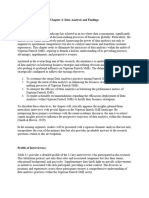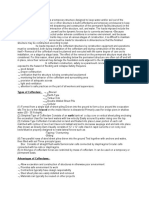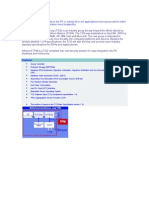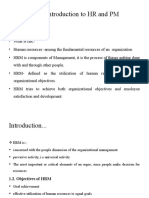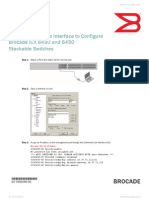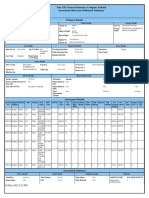Chapter Four and Five
Chapter Four and Five
Uploaded by
Babajide AkinpeluCopyright:
Available Formats
Chapter Four and Five
Chapter Four and Five
Uploaded by
Babajide AkinpeluOriginal Description:
Original Title
Copyright
Available Formats
Share this document
Did you find this document useful?
Is this content inappropriate?
Copyright:
Available Formats
Chapter Four and Five
Chapter Four and Five
Uploaded by
Babajide AkinpeluCopyright:
Available Formats
Chapter 4: Data Analysis and Findings
4.1 Introduction
Brief overview of the chapter.
Reiteration of the research aim and objectives.
Objective 1: Examine the current Data Analytics practices of Fintech SMEs in Nigeria.
4.3 Current Practices of Data Analytics in Nigerian Fintech SMEs
4.3.1 Overview of Data Analytics Adoption
4.3.2 Use of Data Analytics: Evidence from Interviews
o Integration of quotes and codes.
o Presentation of data through tables showcasing frequency and nature of analytics
use.
4.3.3 Tools & Platforms in Use
o Analysis of commonly used tools and platforms.
o Discussion of benefits and challenges associated with specific tools.
o Charts showing the distribution of tool preference among participants.
Objective 2: Assess the benefit of data analytics on Nigerian Fintech SMEs' in improving
business strategies & decision-making processes.
4.4 Benefits of Data Analytics for Business Strategies & Decision-making Processes
4.4.1 Role in Strategy Formulation
o How analytics has reshaped strategy formulation among Fintech SMEs.
o Integration of quotes and codes.
o Tables illustrating the perceived benefits, with references to participant responses.
4.4.2 Enhancing Decision-making
o Discussion of the impact on daily to high-level decision-making processes.
o Real-world implications and outcomes based on interviewee feedback.
o Charts displaying the frequency of decision-making enhancement due to
analytics.
Objective 3: Analyze the efficacy of Data Analytics in maximizing the performance of
Nigerian Fintech SMEs.
4.5 Efficacy of Data Analytics in Maximizing Performance
4.5.1 Impact on Profitability
o Analyzing the tangible returns on investment in analytics.
o Integration of quotes and codes.
o Tables presenting the profit changes reported by interviewees.
4.5.2 Operational Productivity Boosts
o Discussion on process efficiencies and optimization due to analytics.
o Charts visualizing operational boosts reported by participants.
Objective 4: Recommend implementations of Data Analytics in Nigerian Fintech SMEs for
better management of business strategies.
4.6 Challenges in the Implementation and Use of Data Analytics
4.6.1 Infrastructure & Tool Challenges
o Overview of common infrastructural barriers.
o Discussion of tools' limitations as cited by participants.
o Integration of quotes and codes.
o Charts showcasing the frequency of specific challenges.
4.6.2 Data Quality & Cleanliness Concerns
o Addressing the significance of high-quality data.
o The added complexities and challenges in maintaining clean data.
o Tables detailing the common issues reported in data quality.
4.7 Recommendations for Enhanced Implementation of Data Analytics
4.7.1 The Potential of Collaboration & Training
o Exploring avenues for collective growth and learning.
o Tables showing possible areas of collaboration cited by participants.
4.7.2 Integrating Advanced Data Analysis
o Discussion on the next steps: AI, real-time analytics, and more.
o Charts representing interest and inclination toward advanced tools.
4.8 Discussion of Findings
4.8.1 Relating Findings to Existing Literature
o Comparing and contrasting the findings with existing academic and industry
literature.
4.8.2 Implications for Fintech SMEs
o Discussing the broader implications of the findings for Nigerian Fintech SMEs.
4.8.3 Practical Implications
o Exploring the real-world impact and relevance of the findings.
4.8.4 Limitations
o Acknowledging the limitations of the study and how they might influence the
findings.
4.8 Conclusion
Summary of key findings from the analysis.
Bridging the findings to the next chapter on recommendations and conclusion.
A table summarizing the main findings in relation to the objectives.
Chapter Five: Conclusion and Recommendations
5.1 Introduction
Brief overview of the chapter.
Recapitulation of the research aim and objectives.
5.2 Recapitulation of Key Findings
Concise summary of primary findings from each objective.
A short reflection on the significance of these findings.
5.3 Answering the Research Questions
Directly addressing each research question based on the findings and discussions from
the previous chapter.
5.4 Theoretical Implications
Discussion on how the research findings contribute to the existing body of knowledge.
Comparisons with previous research, highlighting similarities, differences, and new
insights.
5.5 Practical Implications
Recommendations for Fintech SMEs in Nigeria based on the study's findings.
Suggestions for policymakers and other stakeholders in the fintech ecosystem.
5.6 Recommendations for Enhanced Implementation
Based on the challenges and gaps identified, provide actionable recommendations for
Nigerian Fintech SMEs to enhance their data analytics practices.
Discussion on the benefits and potential pitfalls of these recommendations.
5.7 Limitations of the Study
Honest acknowledgment of the research's limitations.
Discussion on how these limitations might have influenced the results and interpretations.
5.8 Suggestions for Future Research
Potential areas of study that can be explored further, building on the findings of the
current research.
Suggestions for different methodologies or approaches that future researchers might
consider.
5.9 Concluding Remarks
Reflect on the journey of the research, its significance, and its potential impact.
Final thoughts and reflections on the broader relevance of the study in the context of
Nigerian Fintech SMEs.
5.10 Summary Table of Key Findings and Recommendations
A concise table that presents the primary findings alongside the corresponding
recommendations, making it easy for readers to draw connections.
You might also like
- The Subtle Art of Not Giving a F*ck: A Counterintuitive Approach to Living a Good LifeFrom EverandThe Subtle Art of Not Giving a F*ck: A Counterintuitive Approach to Living a Good LifeRating: 4 out of 5 stars4/5 (5936)
- The Gifts of Imperfection: Let Go of Who You Think You're Supposed to Be and Embrace Who You AreFrom EverandThe Gifts of Imperfection: Let Go of Who You Think You're Supposed to Be and Embrace Who You AreRating: 4 out of 5 stars4/5 (1107)
- Never Split the Difference: Negotiating As If Your Life Depended On ItFrom EverandNever Split the Difference: Negotiating As If Your Life Depended On ItRating: 4.5 out of 5 stars4.5/5 (882)
- Grit: The Power of Passion and PerseveranceFrom EverandGrit: The Power of Passion and PerseveranceRating: 4 out of 5 stars4/5 (598)
- Hidden Figures: The American Dream and the Untold Story of the Black Women Mathematicians Who Helped Win the Space RaceFrom EverandHidden Figures: The American Dream and the Untold Story of the Black Women Mathematicians Who Helped Win the Space RaceRating: 4 out of 5 stars4/5 (925)
- Shoe Dog: A Memoir by the Creator of NikeFrom EverandShoe Dog: A Memoir by the Creator of NikeRating: 4.5 out of 5 stars4.5/5 (545)
- The Hard Thing About Hard Things: Building a Business When There Are No Easy AnswersFrom EverandThe Hard Thing About Hard Things: Building a Business When There Are No Easy AnswersRating: 4.5 out of 5 stars4.5/5 (353)
- Elon Musk: Tesla, SpaceX, and the Quest for a Fantastic FutureFrom EverandElon Musk: Tesla, SpaceX, and the Quest for a Fantastic FutureRating: 4.5 out of 5 stars4.5/5 (476)
- Her Body and Other Parties: StoriesFrom EverandHer Body and Other Parties: StoriesRating: 4 out of 5 stars4/5 (831)
- The Emperor of All Maladies: A Biography of CancerFrom EverandThe Emperor of All Maladies: A Biography of CancerRating: 4.5 out of 5 stars4.5/5 (274)
- The Little Book of Hygge: Danish Secrets to Happy LivingFrom EverandThe Little Book of Hygge: Danish Secrets to Happy LivingRating: 3.5 out of 5 stars3.5/5 (419)
- The World Is Flat 3.0: A Brief History of the Twenty-first CenturyFrom EverandThe World Is Flat 3.0: A Brief History of the Twenty-first CenturyRating: 3.5 out of 5 stars3.5/5 (2271)
- The Yellow House: A Memoir (2019 National Book Award Winner)From EverandThe Yellow House: A Memoir (2019 National Book Award Winner)Rating: 4 out of 5 stars4/5 (99)
- Devil in the Grove: Thurgood Marshall, the Groveland Boys, and the Dawn of a New AmericaFrom EverandDevil in the Grove: Thurgood Marshall, the Groveland Boys, and the Dawn of a New AmericaRating: 4.5 out of 5 stars4.5/5 (270)
- The Sympathizer: A Novel (Pulitzer Prize for Fiction)From EverandThe Sympathizer: A Novel (Pulitzer Prize for Fiction)Rating: 4.5 out of 5 stars4.5/5 (122)
- Team of Rivals: The Political Genius of Abraham LincolnFrom EverandTeam of Rivals: The Political Genius of Abraham LincolnRating: 4.5 out of 5 stars4.5/5 (235)
- A Heartbreaking Work Of Staggering Genius: A Memoir Based on a True StoryFrom EverandA Heartbreaking Work Of Staggering Genius: A Memoir Based on a True StoryRating: 3.5 out of 5 stars3.5/5 (232)
- On Fire: The (Burning) Case for a Green New DealFrom EverandOn Fire: The (Burning) Case for a Green New DealRating: 4 out of 5 stars4/5 (75)
- The Unwinding: An Inner History of the New AmericaFrom EverandThe Unwinding: An Inner History of the New AmericaRating: 4 out of 5 stars4/5 (45)
- Acca IfrsDocument109 pagesAcca Ifrsesam5278No ratings yet
- STA Learning Maps - Controls Factory FY18Document3 pagesSTA Learning Maps - Controls Factory FY18jose2525No ratings yet
- Example DissertationDocument137 pagesExample DissertationBabajide AkinpeluNo ratings yet
- Data Analytics ProposalDocument13 pagesData Analytics ProposalBabajide AkinpeluNo ratings yet
- Chapter Four and Five Data AnalyticsDocument29 pagesChapter Four and Five Data AnalyticsBabajide AkinpeluNo ratings yet
- Akinpelu, Babajide Adedotun: No26, Abayomi Akimosa Idi-Sin, Jericho IbadanDocument3 pagesAkinpelu, Babajide Adedotun: No26, Abayomi Akimosa Idi-Sin, Jericho IbadanBabajide AkinpeluNo ratings yet
- CofferdamDocument3 pagesCofferdambabubhai23100% (1)
- Integrated Goods and Service Tax (IGST)Document21 pagesIntegrated Goods and Service Tax (IGST)Avinash As AviNo ratings yet
- Evolve 2 Unit - 7 Quiz - 2Document3 pagesEvolve 2 Unit - 7 Quiz - 2Abderrahim Fatmi33% (3)
- BHCS38896 Panametrics PanaFlow LC Datasheet - R12 1Document8 pagesBHCS38896 Panametrics PanaFlow LC Datasheet - R12 1cinthiacruzNo ratings yet
- Domain 5 Planning, Assessing and ReportingDocument10 pagesDomain 5 Planning, Assessing and ReportingChristy100% (1)
- Maza Vs Sec GonzalesDocument4 pagesMaza Vs Sec GonzalesJames LanzarNo ratings yet
- Automotive Transmission: Presented byDocument48 pagesAutomotive Transmission: Presented bySumit Sharma100% (1)
- CLA Cattle Market Report April 05, 2023Document1 pageCLA Cattle Market Report April 05, 2023Clovis Livestock AuctionNo ratings yet
- Full Paper No 43 M 2Document9 pagesFull Paper No 43 M 2Anonymous 8qUHG4SlNo ratings yet
- Project-Report SampleDocument59 pagesProject-Report SampleNile SethNo ratings yet
- Asset-12228518 RETAIL LUMINAIRE PROGRAM 2020-2B2021Document388 pagesAsset-12228518 RETAIL LUMINAIRE PROGRAM 2020-2B2021demetrio lopezNo ratings yet
- Econ 3 MidtermDocument1 pageEcon 3 MidtermEarl Russell S PaulicanNo ratings yet
- Peenscan Pen Instruction ManualDocument13 pagesPeenscan Pen Instruction ManualPanneer SelvamNo ratings yet
- Project CharterDocument28 pagesProject CharterAli SyedNo ratings yet
- TPM WhitepaperDocument12 pagesTPM Whitepaperapi-3760834No ratings yet
- ANN - Perceptron - AdalineDocument15 pagesANN - Perceptron - AdalineDhanushMKuberNo ratings yet
- Kenwood Stereo Reverberation Amplifier Ra-59Document8 pagesKenwood Stereo Reverberation Amplifier Ra-59lunwenNo ratings yet
- HRPM PPT 1Document26 pagesHRPM PPT 1temesgen yohannesNo ratings yet
- Giglio Letter To Local Law EnforcementDocument4 pagesGiglio Letter To Local Law EnforcementAlbuquerque JournalNo ratings yet
- H1000 Smart Thermometer: Key FeatureDocument3 pagesH1000 Smart Thermometer: Key FeatureEstrella LopezNo ratings yet
- 19 C New PO 56235256201449 DT 01-SEP-23 On VINDHYA TELELINKS LIMITED-REWADocument8 pages19 C New PO 56235256201449 DT 01-SEP-23 On VINDHYA TELELINKS LIMITED-REWAManojNo ratings yet
- Rule: Fishery Conservation and Management: Alaska Fisheries of Exclusive Economic Zone— Pacific Coast Groundfish CorrectionDocument16 pagesRule: Fishery Conservation and Management: Alaska Fisheries of Exclusive Economic Zone— Pacific Coast Groundfish CorrectionJustia.comNo ratings yet
- Tourism Business PlanDocument96 pagesTourism Business Plan20me02022No ratings yet
- Google Sketch Up ProjectsDocument89 pagesGoogle Sketch Up ProjectsVidyasagarChennaNo ratings yet
- SymphonyAI OverviewDocument8 pagesSymphonyAI Overviewmahesh KumarNo ratings yet
- ICX6430-6450 07400 QuickStartGuideDocument2 pagesICX6430-6450 07400 QuickStartGuideDavid MateosNo ratings yet
- Ss Material List 2Document10 pagesSs Material List 2stejakumarsam123No ratings yet
- The Resource of This Report Item Is Not ReachableDocument2 pagesThe Resource of This Report Item Is Not Reachableparentsareworld7No ratings yet












































